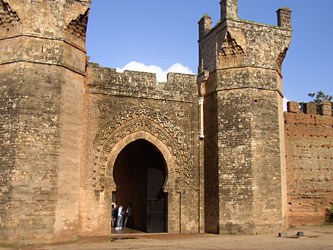![[Mausoleum of Muhammad V]](images/rabat/mausoleum.jpg)
![]()
![[Hassan Tower]](images/rabat/hassan_tower.jpg)
Situated atop one of the main elevations of the city, the Mausoleum of King Muhammad V, a 20th century Alouite building, faces the 12th century Hassan Tower. “To mark the victories of the Moroccan armies over the Spanish in the battle of Alarcos, Ya‘qub al-Mansur set out in 1196 to build the mosque still known by its minaret, the Tower of Hassan.” (Landau, 1967: 147) The huge dimensions of the mosque—180 by 140 meters—can only be imagined from the rows of broken columns; it was never completed and was destroyed by an earthquake in 1755.
![[cafe in Oudias casba]](images/rabat/cafe.jpg)
![]()
![[cat in cafe]](images/rabat/cafe_cat.jpg)
The narrow, twisting streets of the Oudaïas fortress, which dates from the 12th century, are beautiful in the rain. Respite is found in the Café Maure, a popular tourist haunt, where superb cookies and pastries are served with mint tea. The resident cats and kittens expect to share the goodies with patrons. A glimpse of the Andalusian style garden is seen through the archway.

![]()

The town of Chella was founded by the Phoenicians. So named Sala Colonia, it was the southernmost outpost of the Roman province of Mauretania Tingitania; Roman ruins date from around 200 BC to 330 AD. The site was abandoned in 1154 for the town of Salé across the river mouth.. “...It was under the Merinids that Chella acquired its true Islamic personality. The impressive ramparts that surround it to the present day were begun by the Merinid Sultan Abu Sa‘id (1300-31) and finished by his son Abu al-Hassan in 1339. It then became the necropolis of the royal house and a retreat for religious devotion." (Landau, 1967: 138)
![[Chella doorway]](images/rabat/chella_door.jpg)

![[zawia, Chella]](images/rabat/chella_zawia.jpg)
The ruins of the Merinid sanctuary include a mosque, a zawiya, several royal shrines and many tombs. In 1500 Leo Africanus counted 32 Merinid graves, but the number apparent today is much less (Rogerson, 2000: 204). The central court of the zawiya has a rectangular pool connected by channels to marble basins for water jets that drained into the pool. The pool was flanked by thin marble columns, and against the walls were small cells.
![[mosque, Chella]](images/rabat/chella_mosque.jpg)

![[Chella tomb]](images/rabat/chella_tomb.jpg)

![[Chella tomb inscription]](images/rabat/chella_inscr.jpg)
The mosque is in ruins, and storks nest atop its minaret. Nearby are the royal tombs still decorated with beautiful calligraphy and zellige The middle image and detail to the right are from the tomb of the Merinid sultan Abu’l-Hasan and his queen (Brett & Fentress, 1996, plate 4.2).
Merinid architecture remains some of the most beautiful in Morocco. It may also have directly influenced the style of the Court of the Lions in the Alhambra. “However, the most striking prototype for the Court of the Lions is to be found in Salé, the main port of Merinid Morocco. ... It is unlikely to be a coincidence that the vizier Ibn al-Khatib, who must have been closely involved with the building of the Court of the Lions, spent most of his years in exile in Salé. ... The intimacy of its scale and extravagant decoration anticipates those features in the Alhambra’s Court of the Lions. The similarity of the filigree stucco work at the Salé madrasa to that in the Alhambra is striking and suggests the possibility of a common pool of artisans.” (Irwin, 2004: 91-93)
Return to The Fabulous Morocco Trip
References:
Brett, M., and E. Fentress. 1996. The Berbers. Oxford, Blackwell Publ. 350 pp.
Irwin, R. 2004. The Alhambra. Cambridge, Harvard Univ. Pr. 213 pp.
Landau, R., (text) and W. Swaan (photographs). 1967. Morocco: Marrakesh, Fez, Rabat. New York, G. P. Putnam’s Sons. 160 pp.
Rogerson, B. 2000. Morocco. London, Cadogan Guides. 600 pp. [p. 203 has a clear map of the Merinid sanctuary]